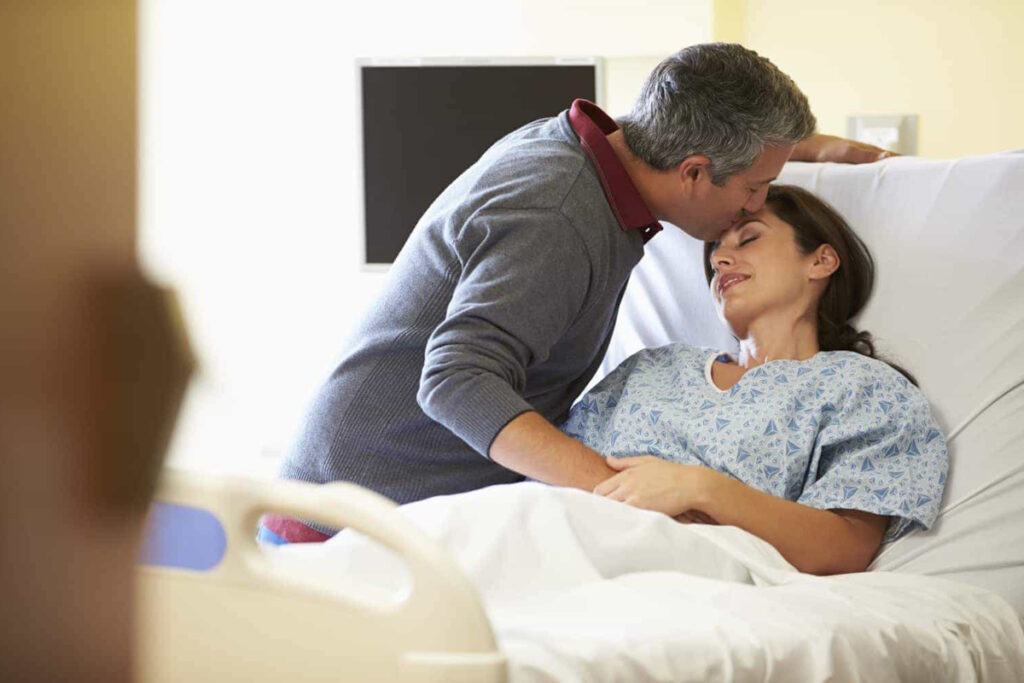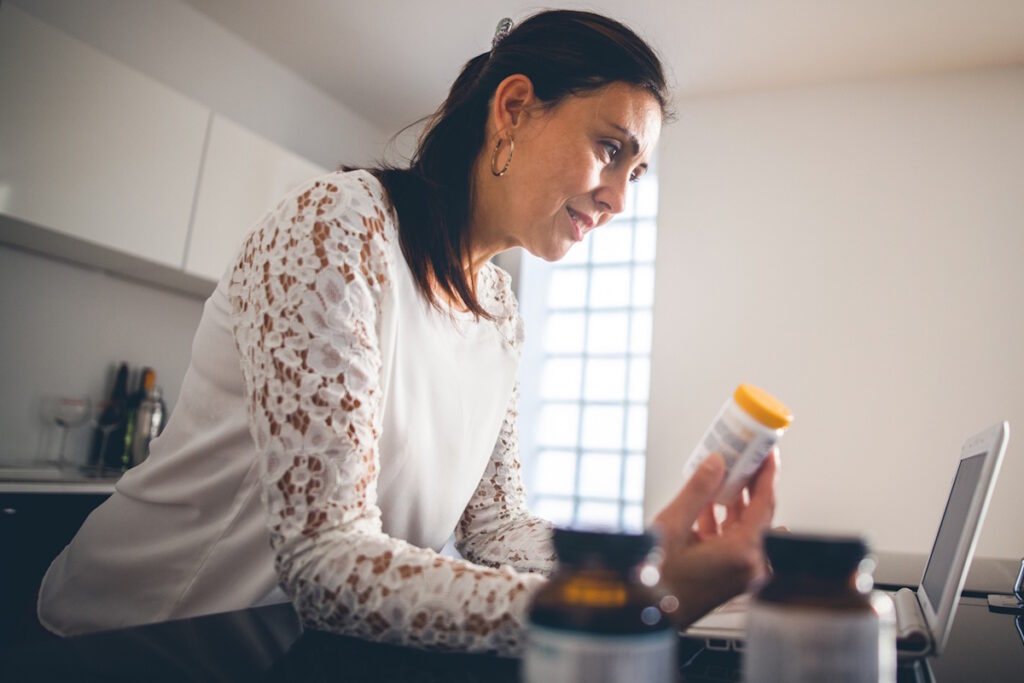When Drew’s spouse, Georgia*, scheduled her Uterine Fibroid Embolization last year, the first thing Drew did was hold Georgia’s hand. They were both confident that UFE was the answer to finally putting Georgia’s uterine fibroid symptoms behind her. They were also looking forward to Georgia feeling like her old self again. Holding her hand in that moment was Drew’s way of assuring her that she wasn’t alone. She had a supportive caregiver, and whatever happened next, they would get through it together. With that said, Drew wasn’t exactly sure what being a caregiver after a UFE procedure meant and even asked the doctor, “What will Georgia need from me during recovery?”
At Fibroid Institute Texas, we love it when someone—a spouse, sibling, partner, parent, or close friend—steps up as a caregiver for our UFE patients. Caregivers are an integral part of the process before, during, and after a UFE procedure. Their questions and concerns are absolutely valid. After all, there is always a little anxiety heading into any procedure. The good news is that UFE has quickly become the gold standard for non-surgical, outpatient fibroid treatment. Additionally, at Fibroid Institute Texas, we have developed a highly specific formula of success and patient support from a procedure-prep and post-procedure standpoint. As a result, our patients report little to no pain when they follow the recommended medicine chart, and our caregivers have a clearer and less-overwhelming picture of what is expected of them during the recovery process.
What Caregivers Can Expect During a UFE Procedure
An important first step for any caregiver is to understand what your loved one is about to go through with her scheduled UFE procedure. After all, many people think that being a caregiver automatically requires a massive time commitment and intensive 24-7 care. In their mind, the person they care for will be bedridden and have a long recovery road ahead.
It’s quite the opposite with UFE.
Rather than undergoing an invasive surgery followed by a hospital stay, UFE is a same-day outpatient procedure. Instead of removing fibroids requiring incisions and resulting in scars, UFE shrinks the fibroids. As a result, recovery time is reduced, and over 90% of patients see highly effective results. In fact, Fibroid Institute Texas offers UFE to patients in the comfort of our offices equipped with advanced medical technology to relieve them of fibroid symptoms such as:
- Heavy menstrual bleeding or clotting
- Pelvic pain, pressure, or cramps
- Urinary frequency
- Constipation
- Anemia
- Back or leg pain
- Pain during intercourse
- Periods that last longer than a week
- Excessive fatigue
- Weight gain
Here’s how UFE works
Our experienced fibroid specialists will make a tiny nick on the patient’s left wrist. A very small catheter is inserted and advanced to the uterine arteries using image-guided interventional radiology. The physician will use X-ray guidance to locate the vessels that supply blood to the fibroids. Small particles are injected into the vessels, blocking blood flow to the fibroids, and causing them to shrink. As previously mentioned, there is no hospital stay and no incision. UFE can treat all fibroids at one time, so there is no need for multiple treatment sessions. Furthermore, recovery generally takes about 7 days for most women.
Patients and caregivers need to know the following:
- Our office orders medications and has them ready for patients on the day of the UFE procedure
- The procedure will only last about an hour
- Patients will be asleep during the procedure
- An anesthesiologist and nurse anesthetist monitor the patients to keep them comfortable throughout the procedure

Wondering “is UFE right for my loved one?”
Download a free checklist to see if she is eligible for fibroid treatment without surgery.
Caregiver Support Tips After UFE Procedure
Some women experience vaginal bleeding after their UFE procedure, which typically becomes lighter in the months following UFE. Cramping is also normal and will become less frequent, and they can resume light activities as soon as they feel up to it. In fact, most women return to work in 7-10 days. In the meantime, they’ll be relying on you, the caregiver, for a variety of comfort needs in the first few days following the procedure.
Here are a few caregiver support tips we suggest:
1. Read all post-procedure instructions
You’ll want to make sure you and your loved one are aware of potential side effects, including the possibility of fever, chills, or excessive bleeding. If any of these situations arise, it’s important to recognize them quickly and immediately bring them to the doctor’s attention. Moreover, we have created a specific medicine chart for your loved one. Following it to a T ensures a faster recovery.
2. Be on call
While recovery time is fast following a UFE procedure, it’s nice for a patient to know they have a caregiver accessible at a moment’s notice to help with things like medication and meals. While not necessary, if you can take a few days off from work or work from home, your loved one will appreciate it.
3. Stay on top of the medicine schedule
Some women have said the prescribed medicine made them feel sleepy and a little loopy during recovery. While this is completely normal, a potential negative is that they might forget to stay on schedule with the next dose. If you’re the caregiver, it will be helpful to keep medications on schedule.

4. Keep everything close by
When you aren’t readily available, it’s a good idea to set up a “station” of sorts that’s close to the patient’s bed and has everything they need. This includes plenty of water and medicine within reach, but don’t forget things like a good book, the television remote, reading glasses, heating pads, and their mobile phone. Some patients had even said their caregiver bought them a bell to jingle when they needed help.
5. Take care of the little things
At least for the first three days after the UFE procedure, your loved one shouldn’t lift more than five pounds. Therefore, you should take care of things like cooking, cleaning, taking out the trash, meal prepping, running errands, keeping the kids entertained, and more.
6. Lots of hugs
While this may seem like a no-brainer, it’s worth mentioning. Even after a successful UFE procedure, your loved one will undoubtedly need encouragement, reassurance that they did great and are on the road to recovery, love, and hugs as they work through the first few days of lingering pain.

How else can you help support a fibroid patient? Firstly, having a fibroid doctor who is open to back-and-forth dialogue, answers every question or concern, sets expectations along the way, and honors a patient’s wishes is one significant way to help your loved one feel more in control and have less fear of fibroid treatment. The second is the UFE procedure, which by itself is a simple solution to eliminating symptoms. And last but not least, having a caring and compassionate caregiver at home for the first few days after the procedure ensures that recovery goes as smoothly as possible.
Direct Patient Access to Doctors at Fibroid Institute
Being a caregiver for someone who has undergone a medical procedure can be overwhelming. All they want is to feel better faster, and you want nothing more than to ensure they are as comfortable as possible. The good news is that being a caregiver for someone who has undergone a UFE procedure can be just as easy to manage as the fibroid treatment itself.
With the UFE procedure, your friend or loved one isn’t stuck with bloody surgeries such as hysterectomy or myomectomy. At Fibroid Institute Texas, we make the process streamlined and easy as 1-2-3. In fact, our office handles all orders for MRIs and diagnostic scans. We also handle all insurance pre-authorizations. Additionally, fibroid treatment is scheduled in the comfort of our clinics equipped with advanced medical technology.
With each UFE procedure, patients and their caregivers are empowered. We help patients achieve their full potential without being limited by fibroid symptoms or lengthy recovery times. For many women, the UFE procedure changed their lives.
Most major medical insurance providers cover the cost of UFE. You will need a formal consultation to determine if you are a candidate before scheduling your procedure. Call for a telehealth consult or an in-office appointment in Dallas at 214-838-6440 or Houston at 713-903-3733 or complete the form below.
"*" indicates required fields
Fibroid Institute Texas serves the Dallas and Houston areas including Fort Worth, Grand Prairie, HEB, Arlington, Hutchins, Irving, Duncanville, DeSoto, Cedar Hill, Lancaster, Cockrell Hill, Highland Park, University Park, Park Cities, Garland, Mesquite, Richardson, Dallas, Sherman, Houston, Sugar Land, Katy, Webster, Clear Lake, The Woodlands, Universal City, Spring, Kingwood, Stafford, Conroe, Texas City, Cypress, League City, Bellaire, Addison, Carrollton, Plano, Frisco, McKinney, Craig Ranch, Allen, and more.
Prior to starting any new treatment or if you have questions regarding a medical condition, always seek the advice of your doctor or other qualified health provider. This information is not a substitute for professional medical advice.
*Patient stories are true. Names and/or photos may be changed to protect patient confidentiality.

